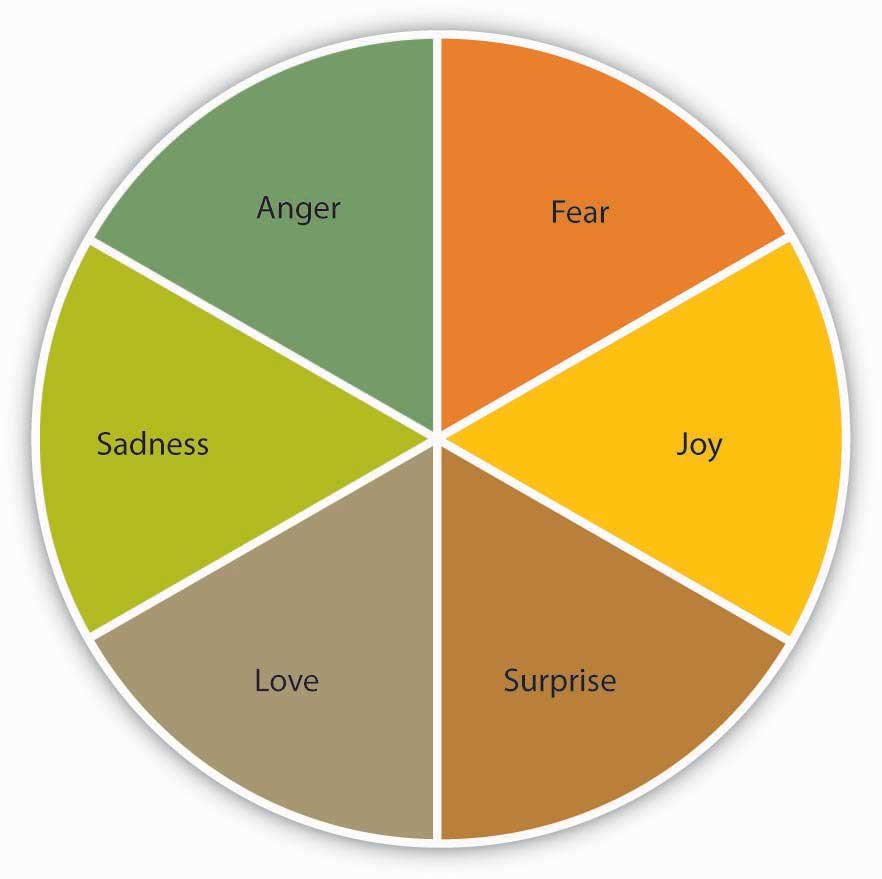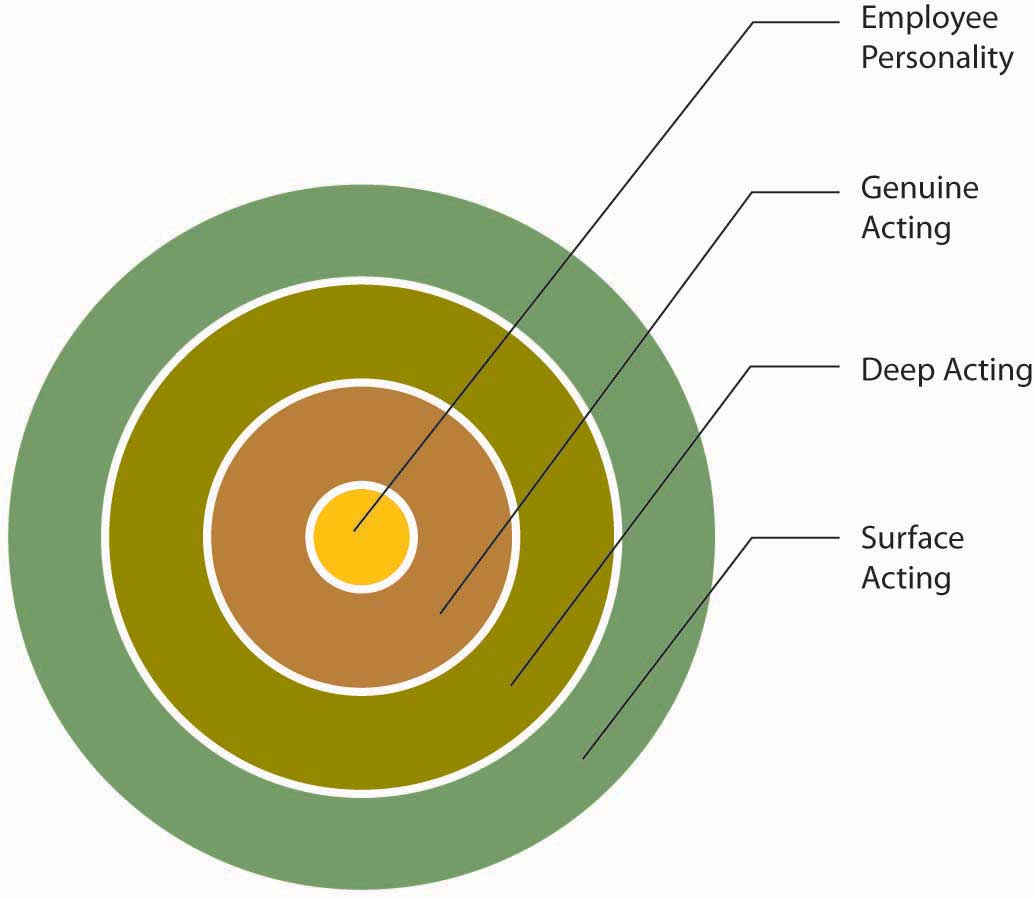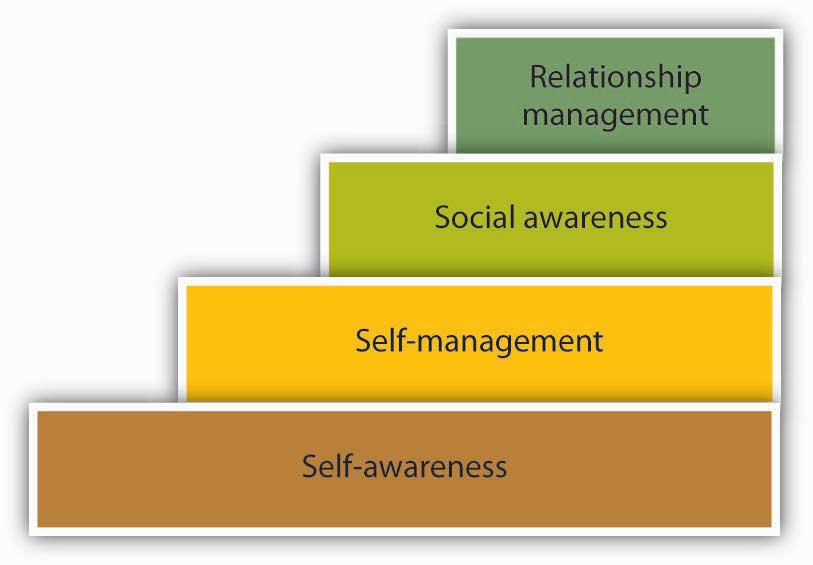This is “Emotions at Work”, section 7.5 from the book An Introduction to Organizational Behavior (v. 1.1). For details on it (including licensing), click here.
For more information on the source of this book, or why it is available for free, please see the project's home page. You can browse or download additional books there. To download a .zip file containing this book to use offline, simply click here.
7.5 Emotions at Work
Learning Objectives
- Understand Affective Events Theory.
- Understand the influence of emotions on attitudes and behaviors at work.
- Learn what emotional labor is and how it affects individuals.
- Learn what emotional intelligence is.
Emotions Affect Attitudes and Behaviors at Work
Emotions shape an individual’s belief about the value of a job, a company, or a team. Emotions also affect behaviors at work. Research shows that individuals within your own inner circle are better able to recognize and understand your emotions.Elfenbein, H. A., & Ambady, N. (2002). Is there an in-group advantage in emotion recognition? Psychological Bulletin, 128, 243–249.
So, what is the connection between emotions, attitudes, and behaviors at work? This connection may be explained using a theory named Affective Events Theory (AET)A theory that explores how events on the job cause different kinds of people to feel different emotions.. Researchers Howard Weiss and Russell Cropanzano studied the effect of six major kinds of emotions in the workplace: anger, fear, joy, love, sadness, and surprise.Weiss, H. M., & Cropanzano, R. (1996). Affective events theory: A theoretical discussion of the structure, causes and consequences of affective experiences at work. Research in Organizational Behavior, 18, 1–74. Their theory argues that specific events on the job cause different kinds of people to feel different emotions. These emotions, in turn, inspire actions that can benefit or impede others at work.Fisher, C. D. (2002). Real-time affect at work: A neglected phenomenon in organizational behaviour. Australian Journal of Management, 27, 1–10.
Figure 7.11

According to Affective Events Theory, six emotions are affected by events at work.
For example, imagine that a coworker unexpectedly delivers your morning coffee to your desk. As a result of this pleasant, if unexpected experience, you may feel happy and surprised. If that coworker is your boss, you might feel proud as well. Studies have found that the positive feelings resulting from work experience may inspire you to do something you hadn’t planned to do before. For instance, you might volunteer to help a colleague on a project you weren’t planning to work on before. Your action would be an affect-driven behaviorBehavior that occurs when emotions trigger you to respond in a particular way..Fisher, C. D. (2002). Real-time affect at work: A neglected phenomenon in organizational behaviour. Australian Journal of Management, 27, 1–10. Alternatively, if you were unfairly reprimanded by your manager, the negative emotions you experience may cause you to withdraw from work or to act mean toward a coworker. Over time, these tiny moments of emotion on the job can influence a person’s job satisfaction. Although company perks and promotions can contribute to a person’s happiness at work, satisfaction is not simply a result of this kind of “outside-in” reward system. Job satisfaction in the AET model comes from the inside-in—from the combination of an individual’s personality, small emotional experiences at work over time, beliefs, and affect-driven behaviors.
Jobs that are high in negative emotion can lead to frustration and burnoutOngoing negative emotional state resulting from dissatisfaction.—an ongoing negative emotional state resulting from dissatisfaction.Lee, R. T., & Ashforth, B. E. (1996). A meta-analytic examination of the correlates of three dimensions of job burnout. Journal of Applied Psychology, 81, 123–133; Maslach, C. (1982). Burnout: The cost of caring. Englewood Cliffs, NJ: Prentice Hall; Maslach, C., & Jackson, S. E. (1981). The measurement of experienced burnout. Journal of Occupational Behavior, 2, 99–113. Depression, anxiety, anger, physical illness, increased drug and alcohol use, and insomnia can result from frustration and burnout, with frustration being somewhat more active and burnout more passive. The effects of both conditions can impact coworkers, customers, and clients as anger boils over and is expressed in one’s interactions with others.Lewandowski, C. A. (2003, December 1). Organizational factors contributing to worker frustration: The precursor to burnout. Journal of Sociology & Social Welfare, 30, 175–185.
Emotional Labor
Negative emotions are common among workers in service industries. Individuals who work in manufacturing rarely meet their customers face-to-face. If they’re in a bad mood, the customer would not know. Service jobs are just the opposite. Part of a service employee’s job is appearing a certain way in the eyes of the public. Individuals in service industries are professional helpers. As such, they are expected to be upbeat, friendly, and polite at all times, which can be exhausting to accomplish in the long run.
Humans are emotional creatures by nature. In the course of a day, we experience many emotions. Think about your day thus far. Can you identify times when you were happy to deal with other people and times that you wanted to be left alone? Now imagine trying to hide all the emotions you’ve felt today for 8 hours or more at work. That’s what cashiers, school teachers, massage therapists, fire fighters, and librarians, among other professionals, are asked to do. As individuals, they may be feeling sad, angry, or fearful, but at work, their job title trumps their individual identity. The result is a personaA professional role that involves acting out potentially artificial feelings as part of a job.—a professional role that involves acting out feelings that may not be real as part of their job.
Emotional laborThe regulation of feelings and expressions for organizational purposes. refers to the regulation of feelings and expressions for organizational purposes.Grandey, A. (2000). Emotional regulations in the workplace: A new way to conceptualize emotional labor. Journal of Occupational Health Psychology, 5, 95–110. Three major levels of emotional labor have been identified.Hochschild, A. (1983). The managed heart. Berkeley, CA: University of California Press.
- Surface actingBehavior requiring individuals to exhibit physical signs, such as smiles, that reflect emotions they don’t feel. requires an individual to exhibit physical signs, such as smiling, that reflect emotions customers want to experience. A children’s hairdresser cutting the hair of a crying toddler may smile and act sympathetic without actually feeling so. In this case, the person is engaged in surface acting.
- Deep actingBehavior requiring an individual to pretend to experience emotions they don’t feel. takes surface acting one step further. This time, instead of faking an emotion that a customer may want to see, an employee will actively try to experience the emotion they are displaying. This genuine attempt at empathy helps align the emotions one is experiencing with the emotions one is displaying. The children’s hairdresser may empathize with the toddler by imagining how stressful it must be for one so little to be constrained in a chair and be in an unfamiliar environment, and the hairdresser may genuinely begin to feel sad for the child.
- Genuine actingBehavior requiring an individual to display emotions aligned with their own. occurs when individuals are asked to display emotions that are aligned with their own. If a job requires genuine acting, less emotional labor is required because the actions are consistent with true feelings.
Figure 7.12

When it comes to acting, the closer to the middle of the circle that your actions are, the less emotional labor your job demands. The further away, the more emotional labor the job demands.
Research shows that surface acting is related to higher levels of stress and fewer felt positive emotions, while deep acting may lead to less stress.Beal, D. J., Trougakos, J. P., Weiss, H. M., & Green, S. G. (2006). Episodic processes in emotional labor: Perceptions of affective delivery and regulation strategies. Journal of Applied Psychology, 91, 1053–1065; Grandey, A. A. (2003). When “the show must go on”: Surface acting and deep acting as determinants of emotional exhaustion and peer-rated service delivery. Academy of Management Journal, 46, 86–96. Emotional labor is particularly common in service industries that are also characterized by relatively low pay, which creates the added potentials for stress and feelings of being treated unfairly.Glomb, T. M., Kammeyer-Mueller, J. D., & Rotundo, M. (2004). Emotional labor demands and compensating wage differentials. Journal of Applied Psychology, 89, 700–714; Rupp, D. E., & Sharmin, S. (2006). When customers lash out: The effects of customer interactional injustice on emotional labor and the mediating role of discrete emotions. Journal of Applied Psychology, 91, 971–978. In a study of 285 hotel employees, researchers found that emotional labor was vital because so many employee-customer interactions involve individuals dealing with emotionally charged issues.Chu, K. (2002). The effects of emotional labor on employee work outcomes. Unpublished doctoral dissertation, Virginia Polytechnic Institute and State University. Emotional laborers are required to display specific emotions as part of their jobs. Sometimes, these are emotions that the worker already feels. In that case, the strain of the emotional labor is minimal. For example, a funeral director is generally expected to display sympathy for a family’s loss, and in the case of a family member suffering an untimely death, this emotion may be genuine. But for people whose jobs require them to be professionally polite and cheerful, such as flight attendants, or to be serious and authoritative, such as police officers, the work of wearing one’s “game face” can have effects that outlast the working day. To combat this, taking breaks can help surface actors to cope more effectively.Beal, D. J., Green, S. G., & Weiss, H. (2008). Making the break count: An episodic examination of recovery activities, emotional experiences, and positive affective displays. Academy of Management Journal, 51, 131–146. In addition, researchers have found that greater autonomy is related to less strain for service workers in the United States as well as France.Grandey, A. A., Fisk, G. M., & Steiner, D. D. (2005). Must “service with a smile” be stressful? The moderating role of personal control for American and French employees. Journal of Applied Psychology, 90, 893–904.
Cognitive dissonanceA term that refers to a mismatch among emotions, attitudes, beliefs, and behavior. is a term that refers to a mismatch among emotions, attitudes, beliefs, and behavior, for example, believing that you should always be polite to a customer regardless of personal feelings, yet having just been rude to one. You’ll experience discomfort or stress unless you find a way to alleviate the dissonance. You can reduce the personal conflict by changing your behavior (trying harder to act polite), changing your belief (maybe it’s OK to be a little less polite sometimes), or by adding a new fact that changes the importance of the previous facts (such as you will otherwise be laid off the next day). Although acting positive can make a person feel positive, emotional labor that involves a large degree of emotional or cognitive dissonance can be grueling, sometimes leading to negative health effects.Zapf, D. (2006). On the positive and negative effects of emotion work in organizations. European Journal of Work and Organizational Psychology, 15, 1–28.
Emotional Intelligence
One way to manage the effects of emotional labor is by increasing your awareness of the gaps between real emotions and emotions that are required by your professional persona. “What am I feeling? And what do others feel?” These questions form the heart of emotional intelligenceHow people can understand each other more completely by becoming more aware of their own and others’ emotions.. The term was coined by psychologists Peter Salovey and John Mayer and was popularized by psychologist Daniel Goleman in a book of the same name. Emotional intelligence looks at how people can understand each other more completely by developing an increased awareness of their own and others’ emotions.Carmeli, A. (2003). The relationship between emotional intelligence and work attitudes, behavior and outcomes: An examination among senior managers. Journal of Managerial Psychology, 18, 788–813.
There are four building blocks involved in developing a high level of emotional intelligence. Self-awarenessThis exists when you are able to accurately perceive, evaluate, and display appropriate emotions. exists when you are able to accurately perceive, evaluate, and display appropriate emotions. Self-managementThis exists when you are able to direct your emotions in a positive way when needed. exists when you are able to direct your emotions in a positive way when needed. Social awarenessThis exists when you are able to understand how others feel. exists when you are able to understand how others feel. Relationship managementThis exists when you are able to help others manage their own emotions and truly establish supportive relationships with others. exists when you are able to help others manage their own emotions and truly establish supportive relationships with others.Elfenbein, H. A., & Ambady, N. (2002). Predicting workplace outcomes from the ability to eavesdrop on feelings. Journal of Applied Psychology, 87, 963–971; Weisinger, H. (1998). Emotional intelligence at work. San Francisco: Jossey-Bass.
Figure 7.13

The four steps of emotional intelligence build upon one another.
In the workplace, emotional intelligence can be used to form harmonious teams by taking advantage of the talents of every member. To accomplish this, colleagues well versed in emotional intelligence can look for opportunities to motivate themselves and inspire others to work together.Goleman, D. (1995). Emotional intelligence. New York: Bantam Books. Chief among the emotions that helped create a successful team, Goleman learned, was empathy—the ability to put oneself in another’s shoes, whether that individual has achieved a major triumph or fallen short of personal goals.Goleman, D. (1998). Working with emotional intelligence. New York: Bantam Books. Those high in emotional intelligence have been found to have higher self-efficacy in coping with adversity, perceive situations as challenges rather than threats, and have higher life satisfaction, which can all help lower stress levels.Law, K. S., Wong, C., & Song, L. J. (2004). The construct and criterion validity of emotional intelligence and its potential utility for management studies. Journal of Applied Psychology, 89, 483–496; Mikolajczak, M., & Luminet, O. (2008). Trait emotional intelligence and the cognitive appraisal of stressful events: An exploratory study. Personality and Individual Differences, 44, 1445–1453.
Key Takeaway
Emotions affect attitudes and behaviors at work. Affective Events Theory can help explain these relationships. Emotional labor is higher when one is asked to act in a way that is inconsistent with personal feelings. Surface acting requires a high level of emotional labor. Emotional intelligence refers to understanding how others are reacting to our emotions.
Exercises
- What is the worst job you have ever had (or class project if you haven’t worked)? Did the job require emotional labor? If so, how did you deal with it?
- Research shows that acting “happy” when you are not can be exhausting. Why do you think that is? Have you ever felt that way? What can you do to lessen these feelings?
- How important do you think emotional intelligence is at work? Why?




